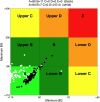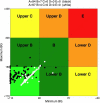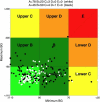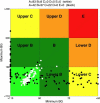Run-to-run tuning of model predictive control for type 1 diabetes subjects: in silico trial
- PMID: 20144422
- PMCID: PMC2769897
- DOI: 10.1177/193229680900300512
Run-to-run tuning of model predictive control for type 1 diabetes subjects: in silico trial
Abstract
Background: The technological advancements in subcutaneous continuous glucose monitoring and insulin pump delivery systems have paved the way to clinical testing of artificial pancreas devices. The experience derived by clinical trials poses technological challenges to the automatic control expert, the most notable being the large interpatient and intrapatient variability and the inherent uncertainty of patient information.
Methods: A new model predictive control (MPC) glucose control system is proposed. The starting point is an MPC algorithm applied in 20 type 1 diabetes mellitus (T1DM) subjects. Three main changes are introduced: individualization of the ARX model used for prediction; synthesis of the MPC law on top of the open-loop basal/bolus therapy; and a run-to-run approach for implementing day-by-day tuning of the algorithm. In order to individualize the ARX model, a sufficiently exciting insulin profile is imposed by splitting the premeal bolus into two smaller boluses (40% and 60%) injected 30 min before and 30 min after the meal.
Results: The proposed algorithm was tested on 100 virtual subjects extracted from an in silico T1DM population. The trial simulates 44 consecutive days, during which the patient receives breakfast, lunch, and dinner each day. For 10 days, meals are multiplied by a random variable uniformly distributed in [0.5, 1.5], while insulin delivery is based on nominal meals. Moreover, for 10 days, either a linear increase or decrease of insulin sensitivity (+/-25% of nominal value) is introduced.
Conclusions: The ARX model identification procedure offers an automatic tool for patient model individualization. The run-to-run approach is an effective way to auto-tune the aggressiveness of the closed-loop control law, is robust to meal variation, and is also capable of adapting the regulator to slow parameter variations, e.g., on insulin sensitivity.
2009 Diabetes Technology Society.
Figures






Similar articles
-
Overnight closed-loop insulin delivery with model predictive control: assessment of hypoglycemia and hyperglycemia risk using simulation studies.J Diabetes Sci Technol. 2009 Sep 1;3(5):1109-20. doi: 10.1177/193229680900300514. J Diabetes Sci Technol. 2009. PMID: 20144424 Free PMC article.
-
Control to range for diabetes: functionality and modular architecture.J Diabetes Sci Technol. 2009 Sep 1;3(5):1058-65. doi: 10.1177/193229680900300509. J Diabetes Sci Technol. 2009. PMID: 20144419 Free PMC article.
-
A closed-loop artificial pancreas using model predictive control and a sliding meal size estimator.J Diabetes Sci Technol. 2009 Sep 1;3(5):1082-90. doi: 10.1177/193229680900300511. J Diabetes Sci Technol. 2009. PMID: 20144421 Free PMC article.
-
Physical Activity Capture Technology With Potential for Incorporation Into Closed-Loop Control for Type 1 Diabetes.J Diabetes Sci Technol. 2015 Oct 18;9(6):1208-16. doi: 10.1177/1932296815609949. J Diabetes Sci Technol. 2015. PMID: 26481641 Free PMC article. Review.
-
[What is the current state of the artificial pancreas in diabetes care?].Internist (Berl). 2020 Jan;61(1):102-109. doi: 10.1007/s00108-019-00713-y. Internist (Berl). 2020. PMID: 31863132 Review. German.
Cited by
-
Progress in development of an artificial pancreas.J Diabetes Sci Technol. 2009 Sep 1;3(5):1002-4. doi: 10.1177/193229680900300502. J Diabetes Sci Technol. 2009. PMID: 20144412 Free PMC article.
-
Insulin Sensitivity Index-Based Optimization of Insulin to Carbohydrate Ratio: In Silico Study Shows Efficacious Protection Against Hypoglycemic Events Caused by Suboptimal Therapy.Diabetes Technol Ther. 2018 Feb;20(2):98-105. doi: 10.1089/dia.2017.0248. Diabetes Technol Ther. 2018. PMID: 29355438 Free PMC article.
-
Development of a multi-parametric model predictive control algorithm for insulin delivery in type 1 diabetes mellitus using clinical parameters.J Process Control. 2011 Mar 1;21(3):391-404. doi: 10.1016/j.jprocont.2010.10.003. J Process Control. 2011. PMID: 21516218 Free PMC article.
-
Design of an online-tuned model based compound controller for a fully automated artificial pancreas.Med Biol Eng Comput. 2019 Jul;57(7):1437-1449. doi: 10.1007/s11517-019-01972-5. Epub 2019 Mar 20. Med Biol Eng Comput. 2019. PMID: 30895514
-
"Turn it off!": diabetes device alarm fatigue considerations for the present and the future.J Diabetes Sci Technol. 2013 May 1;7(3):789-94. doi: 10.1177/193229681300700324. J Diabetes Sci Technol. 2013. PMID: 23759412 Free PMC article.
References
-
- Bequette BW. A critical assessment of algorithms and challenges in the development of a closed-loop artificial pancreas. Diabetes Technol Ther. 2005;7(1):28–47. - PubMed
-
- Hovorka R. Continuous glucose monitoring and closed-loop systems. Diabet Med. 2005;23(1):1–12. - PubMed
-
- Magni L, Raimondo DM, Allgower F. Vol. 384. Berlin: Springer; 2009. Nonlinear model predictive control: towards new challenging applications.
-
- Dua P, Doyle FJ, III, Pistikopoulos EN. Model-based blood glucose control for type 1 diabetes via parametric programming. IEEE Trans Biomed Eng. 2006;53(8):1478–1491. - PubMed
Publication types
MeSH terms
Substances
LinkOut - more resources
Full Text Sources
Other Literature Sources
Medical

